Books by Miriam Saqqa Carazo

Ediciones Cátedra, 2024
Transitar las exhumaciones de las fosas comunes de la Guerra Civil es adentrarse en un viaje no s... more Transitar las exhumaciones de las fosas comunes de la Guerra Civil es adentrarse en un viaje no solo a través de los espacios, sino también a través del tiempo. Los primeros actos de desentierro tuvieron lugar en los tumultuosos días de la guerra, bajo el control de las fuerzas sublevadas, y, más tarde, durante la Dictadura del general Franco. Tras más de ochenta años del fin de la guerra, emerge una urgencia vital para la historiografía y la conciencia colectiva de la sociedad: desentrañar el misterio de aquel proceso de exhumaciones, una experiencia reservada exclusivamente a los vencedores de la guerra. Esta obra representa la primera investigación histórica que ahonda en la compleja trama de la gestión legal, forense e ideológica llevada a cabo por las fuerzas sublevadas y la Dictadura respecto a aquellos cuerpos, a los que designaron como "mártires y caídos por Dios y por España" (1936-1951). Es el acto de resucitar una etapa olvidada de las exhumaciones en España, un pasaje velado hasta ahora por los pliegues del tiempo, que abre las puertas para desvelar un complejo entramado jurídico-político de vasto alcance, meticulosamente regulado por las autoridades, orientado exclusivamente hacia el tratamiento y la dignificación de los cadáveres de aquellos exhumados "por Dios y por España".
Papers by Miriam Saqqa Carazo
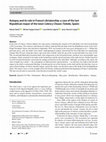
Forensic Science, Medicine and Pathology
In the town of Calera y Chozas (Spain), five mass graves containing the remains of 28 individuals... more In the town of Calera y Chozas (Spain), five mass graves containing the remains of 28 individuals were discovered during a 2012 excavation. The witnesses and historical evidence indicated that the body of the last Republican mayor of the town, Felipe Fernández Varela, who had died in September 1939, was located in the mass grave designated as no. 1. Within this particular grave, only two bodies were found. Anthropological analysis showed that the first individual was significantly younger than 50 years, being the mayor’s age at the time of death, while the age of the second individual was closer to 50. This second individual had a fractured skull, with a depression on the left parietal bone, and there were unmistakable signs of autopsy, which consisted of cut marks on the frontal bone and the sternal extremity of the right clavicle. Further historical research revealed documents concerning the autopsy performed on this individual. Although, according to the report, the cause of deat...
Quaderns de Filologia - Estudis Literaris, 2021
Este artículo se enmarca en el contexto del estudio de los procesos de exhumación de los denomina... more Este artículo se enmarca en el contexto del estudio de los procesos de exhumación de los denominados por la dictadura como "Caídos por Dios y por España", y, dentro de ese marco, se ahonda en una de las prácticas judiciales llevadas a cabo por la "Causa General", las "declaraciones". En ellas se ha podido apreciar un claro accionar de los agentes judiciales como perpetradores, que permite conocer los mecanismos de coerción sobre sus propias "víctimas". De esta manera podemos analizar, desde dentro del proceso, cómo se construyó el relato martirial a través de mecanismos de violencia y cómo la dictadura construyó su imagen de "víctima".
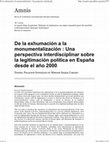
Amnis. Revue de civilisation contemporaine Europes/Amériques, 2019
This text aims to introduce the experience of exhumations and monumentalization of the mass grave... more This text aims to introduce the experience of exhumations and monumentalization of the mass graves of the Spanish Civil War, understanding them as a tool for political legitimation, used recurrently since 2000. The two fundamental facets that will be addressed are exhumation as a tool for legitimisation through the discourse of human rights, and monumentalisation as a tool for legitimisation through the discourse of democratic tradition. Thus, these two rhetorics, that of the recovery of a democratic memory and that of human rights, will determine the character of political legitimacy in the two selected objects of study.
Este texto pretende introducir la experiencia de las exhumaciones y monumentalización de las fosas comunes de la Guerra Civil Española, entendidas como herramientas de legitimación política, utilizadas de manera recurrente desde el año 2000. Planteando las dos facetas fundamentales que abordamos, por una parte la exhumación como herramienta de legitimación a través del discurso de los Derechos Humanos, y en segundo lugar la monumentalización como
herramienta de legitimación a través del discurso de la tradición democrática. Así, estas dos retóricas, la de la recuperación de una memoria democrática y la de los derechos humanos serán las que van a determinar el carácter de legitimación política en los dos objetos de estudio seleccionados.

LIFE AND DEATH IN MEDIAEVAL AND EARLY MODERN TIMES, 2020
The renovation of the church of St. Domingo de Silos in the town of Prádena del Rincón (Madrid), ... more The renovation of the church of St. Domingo de Silos in the town of Prádena del Rincón (Madrid), carried out between 2010 and 2012,
brought to light an unusual discovery – immured and decapitated statues of saints together with a pile of human bones. The sculptures
were carved in wood and dated to the first half of the 14th century according to experts. Two of them were identified as the Virgin Mary
and St. John the Evangelist. The third one may be St. Domingo de Silos or St. Thomas.
An anthropological analysis of the bones revealed that at least 12 individuals were buried there. Of that number, 7 were adults, 4 infants
and 1 new-born. Pathological changes of the bones indicated poor dental health, non-specific stress indicators and traumas.
Immurement, as a method of execution, existed in various epochs. However, in the case of the remains from the church of St. Domingo,
the position of the bones pointed out that it was the secondary burial. However, it is very strange that the bones were buried in such an
unusual place, knowing that a necropolis was located nearby. Possible reasons for that will be discussed in this article.
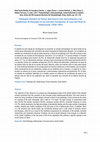
XIII Congreso Nacional de Paleopatología, 2017
El objetivo de este trabajo de investigación es presentar un estudio antropológico de salud denta... more El objetivo de este trabajo de investigación es presentar un estudio antropológico de salud dental de los restos óseos exhumados del cementerio del penal franquista de Valdenoceda (Burgos). Con el objetivo de estudiar las condiciones de vida de estas personas, a través de la patología oral. Para ello se llevó a cabo el estudió de una muestra de 88 individuos masculinos, con un total de 1714 piezas dentales. El elevado número de pérdidas ante-mortem (25.9%), de reabsorción alveolar (58.8 %), la moderada frecuencia de caries (12.7 %), los tratamientos dentales, sumado al gran porcentaje de enfermedad periodontal (58.8%) y al elevado número de cavidades periapicales (29.5%), indican las deficientes condiciones de salud de los últimos años de vida de los presos del penal. Además, existe una relación entre la mala salud dental (ej. enfermedad periodontal) con una amplia gama de factores sistémicos y enfermedades, que encajarían como consecuencia de las condiciones vividas por los individuos de la muestra, a lo largo de su vida y durante su estancia en el penal, desnutrición y enfermedades respiratorias principalmente. Por lo tanto, el conjunto de resultados obtenidos en el análisis supone un reflejo de las condiciones de salud en los últimos años de vida de una población que sufrió un episodio muy concreto de la historia reciente de España. Palabras Clave: Patología oral, Valdenoceda, Penal franquista, Salud dental.
The objective of this research is to present an anthropological study of the dental health of the skeletal remains exhumed from the cemetery of the Francoist prison Valdenoceda (Burgos). This work aimed to study the living conditions of these people, through a study of oral pathology. It was carried out the study of a sample of 88 male individuals, with a total of 1714 teeth. The high number of antemortem tooth loss (25.9%) the alveolar resorption (58.8%), periapical cavities (29.5%), moderate frequency of caries (12.7%), dental treatments, the high percentage of periodontal disease and the large number of periapical cavities, indicate poor health conditions of the last years of life in Valdenoceda prison. In addition, there is a link between poor dental health (eg. periodontal disease) with a wide range of systemic factors and diseases, which fit as a result of the conditions experienced by individuals in the sample, primarily malnutrition and respiratory diseases. Therefore, the set of results obtained in the analysis is a reflection of the health conditions in the last years of life of the population that suffered a specific episode in the recent history of Spain.
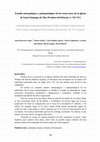
ABSTRACT During the excavation of the medieval church of Santo Domingo de Silos in Prádena (Madri... more ABSTRACT During the excavation of the medieval church of Santo Domingo de Silos in Prádena (Madrid, Spain), a necropolis with at least 245 individuals, buried between the 12th and 15th centuries, was discovered. Out of this number more than 50% were children. A full anthropological and paleopathological study of these individuals was performed. The paleopathological study was divided into infectious, circulatory, metabolic, degenerative and traumatic pathology. We have also analyzed the markers of occupational stress. The discovery of ossuary 36, with the remains of 49 adults and 6 children, was noteworthy; firstly, due to the low proportion of children compared to the rest of the necropolis (71 adults and 119 children). Secondly, it is the only tomb where we found signs of violence, such as intentional traumas and cuts, while in the rest of the necropolis the etiology of traumas seem accidental. And finally for the great number of bones with signs of infection. Considering the historical context of this cemetery (period of Reconquista in central Spain), there are several open hypotheses, such as the possible violent death of those individuals.
Keywords: pathology, trauma, violence, Reconquista
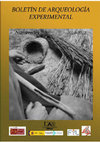
BAEX, Boletín de Arqueología Experimental, 2012
Esta experiencia se enmarca dentro del ambito del estudio tafonomico de los huesos. La importanci... more Esta experiencia se enmarca dentro del ambito del estudio tafonomico de los huesos. La importancia de estos estudios radica en su utilidad a la hora de conocer y distinguir los procesos sufridos por los materiales oseos hasta su hallazgo. Son una de las maneras de acercarse mas y de forma mas concreta a los ambientes humanos con los que se relacionaban. Dentro de estos procesos sufridos por el material oseo esta experiencia se centra en un proceso fisico concreto que da lugar a las marcas de pisadas. Las marcas que aparecen en los restos oseos, y que se han relacionado con el proceso fisico del pisoteo, han sido objeto de estudio desde los anos 80. El estudio de estas marcas se ha visto relacionado con el interes de conocerlas mejor y de esta manera poder diferenciarlas de otras marcas, como son las marcas producidas por la descarnacion, corte o por material litico en general. P. Andrews y J. Cook en 1985 fueron los primeros en senalar la similitud que existia entre ambas marcas, au...
Book chapters by Miriam Saqqa Carazo
Luces sobre un pasado deformado La Guerra Civil ochenta años después. Marcial Pons Historia, 2020
Дискурс легитимации: язык и политика в эпоху глобальных вызовов : монография / Н. В. Грибачева, Д. Диас, А. А. Дорская [и др.] ; под общ. ред. А. В. Колмогоровой. Красноярск : Сиб. pp.142-166, 2019
Memorias de guerra, proyectos de paz: violencias y conflictos entre pasado, presente y futuro., 2017
En los momentos finales e inmediatamente después de la Guerra Civil española (1936-1939) el nuevo... more En los momentos finales e inmediatamente después de la Guerra Civil española (1936-1939) el nuevo estado franquista llevó a cabo un proceso de exhumaciones y gestión de los cuerpos de aquellos considerados como "victimas" de su bando. Esta seria una de las bases sobre las que descansaría el relato victorioso de la Guerra por parte del Régimen a través de la construcción de la figura del "Mártir o Caído por Dios y por España". La presente investigación propone una aproximación a esta figura, al proceso de gestión de los cuerpos y cuál fue la finalidad política del mismo.
Conferences by Miriam Saqqa Carazo
Annual Conference British Association for Biological Anthropology and Osteoarchaeology (BABAO), 15 - 17 September 2023, London (UK), 2023
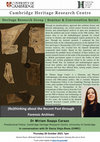
CHRC Lunchtime Heritage Seminars , Oct 26, 2023
Through an interdisciplinary approach that combines history and physical anthropology, my current... more Through an interdisciplinary approach that combines history and physical anthropology, my current project focused attention on forensic and archaeological archives to open new perspectives about the political and social violence of the 20th century. This project aims to set the methodological grounds for critical systems to forensic and archaeological reports produced in the past. Through my doctoral research, I conducted the first historical study on the exhumation processes in the Spanish Civil War and Franco’s Dictatorship (1936-1951). Through judicial and forensic archives, this revealed how the Spanish dictatorship weaponised dead bodies. Based on this experience and to demonstrate the multiple layers of analysis of these archives, my current research focuses on the study of the procedures carried out by British government agents to recover the bodies of their soldiers and civilian populations killed in the context of the Second World War. Its technical and methodological aspects reveal how politics and ideology conditioned these forensic processes and how they affected them, turning aseptic forensic science into a contaminated practice.
Seventh Annual Meeting of the Memory Studies Association (MSA), Newcastle, United Kingdom, 3 - 7 July 2023
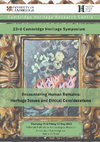
Human remains are not only exposed to inappropriate and unethical use, but also the traces they h... more Human remains are not only exposed to inappropriate and unethical use, but also the traces they have left in the historical archives. Anthropological and medical reports are some places where they are represented. The archives contain graphic material and documents that describe and expose living or dead bodies, many of which have suffered violence in the past. The fact that this material refers to people from other historical moments should not mean an unwise use. Through my research in archives, mainly from violent conflicts of the mid-twentieth century, I have been confronted with judicial and forensic documentation that included images of people who had suffered violent deaths and images of exhumation processes where corpses were exposed, even exhibited. Likewise, the personal information compiled from these individuals is another layer of exposure that must be considered. Throughout my research, I had to ask myself many questions that challenged me on how to use this sensitive documentation for academic proposes. Discussing particular cases, I would like to present the protocols applied in my research. Through these questions and protocols, I intend, among other things, to discuss the necessary level of exposure of this archival material in academic publications and, in turn, to demonstrate the importance of including these ethical approaches in research that confronts past violence and its material evidence.
Asociación Española de Antropología y Odontología Forense (AEAOF) XIV Reunión Científica a la ciudad de Alicante. 4 y 5 de Noviembre, 2022











Uploads
Books by Miriam Saqqa Carazo
Papers by Miriam Saqqa Carazo
Este texto pretende introducir la experiencia de las exhumaciones y monumentalización de las fosas comunes de la Guerra Civil Española, entendidas como herramientas de legitimación política, utilizadas de manera recurrente desde el año 2000. Planteando las dos facetas fundamentales que abordamos, por una parte la exhumación como herramienta de legitimación a través del discurso de los Derechos Humanos, y en segundo lugar la monumentalización como
herramienta de legitimación a través del discurso de la tradición democrática. Así, estas dos retóricas, la de la recuperación de una memoria democrática y la de los derechos humanos serán las que van a determinar el carácter de legitimación política en los dos objetos de estudio seleccionados.
brought to light an unusual discovery – immured and decapitated statues of saints together with a pile of human bones. The sculptures
were carved in wood and dated to the first half of the 14th century according to experts. Two of them were identified as the Virgin Mary
and St. John the Evangelist. The third one may be St. Domingo de Silos or St. Thomas.
An anthropological analysis of the bones revealed that at least 12 individuals were buried there. Of that number, 7 were adults, 4 infants
and 1 new-born. Pathological changes of the bones indicated poor dental health, non-specific stress indicators and traumas.
Immurement, as a method of execution, existed in various epochs. However, in the case of the remains from the church of St. Domingo,
the position of the bones pointed out that it was the secondary burial. However, it is very strange that the bones were buried in such an
unusual place, knowing that a necropolis was located nearby. Possible reasons for that will be discussed in this article.
The objective of this research is to present an anthropological study of the dental health of the skeletal remains exhumed from the cemetery of the Francoist prison Valdenoceda (Burgos). This work aimed to study the living conditions of these people, through a study of oral pathology. It was carried out the study of a sample of 88 male individuals, with a total of 1714 teeth. The high number of antemortem tooth loss (25.9%) the alveolar resorption (58.8%), periapical cavities (29.5%), moderate frequency of caries (12.7%), dental treatments, the high percentage of periodontal disease and the large number of periapical cavities, indicate poor health conditions of the last years of life in Valdenoceda prison. In addition, there is a link between poor dental health (eg. periodontal disease) with a wide range of systemic factors and diseases, which fit as a result of the conditions experienced by individuals in the sample, primarily malnutrition and respiratory diseases. Therefore, the set of results obtained in the analysis is a reflection of the health conditions in the last years of life of the population that suffered a specific episode in the recent history of Spain.
Keywords: pathology, trauma, violence, Reconquista
Book chapters by Miriam Saqqa Carazo
Conferences by Miriam Saqqa Carazo
Este texto pretende introducir la experiencia de las exhumaciones y monumentalización de las fosas comunes de la Guerra Civil Española, entendidas como herramientas de legitimación política, utilizadas de manera recurrente desde el año 2000. Planteando las dos facetas fundamentales que abordamos, por una parte la exhumación como herramienta de legitimación a través del discurso de los Derechos Humanos, y en segundo lugar la monumentalización como
herramienta de legitimación a través del discurso de la tradición democrática. Así, estas dos retóricas, la de la recuperación de una memoria democrática y la de los derechos humanos serán las que van a determinar el carácter de legitimación política en los dos objetos de estudio seleccionados.
brought to light an unusual discovery – immured and decapitated statues of saints together with a pile of human bones. The sculptures
were carved in wood and dated to the first half of the 14th century according to experts. Two of them were identified as the Virgin Mary
and St. John the Evangelist. The third one may be St. Domingo de Silos or St. Thomas.
An anthropological analysis of the bones revealed that at least 12 individuals were buried there. Of that number, 7 were adults, 4 infants
and 1 new-born. Pathological changes of the bones indicated poor dental health, non-specific stress indicators and traumas.
Immurement, as a method of execution, existed in various epochs. However, in the case of the remains from the church of St. Domingo,
the position of the bones pointed out that it was the secondary burial. However, it is very strange that the bones were buried in such an
unusual place, knowing that a necropolis was located nearby. Possible reasons for that will be discussed in this article.
The objective of this research is to present an anthropological study of the dental health of the skeletal remains exhumed from the cemetery of the Francoist prison Valdenoceda (Burgos). This work aimed to study the living conditions of these people, through a study of oral pathology. It was carried out the study of a sample of 88 male individuals, with a total of 1714 teeth. The high number of antemortem tooth loss (25.9%) the alveolar resorption (58.8%), periapical cavities (29.5%), moderate frequency of caries (12.7%), dental treatments, the high percentage of periodontal disease and the large number of periapical cavities, indicate poor health conditions of the last years of life in Valdenoceda prison. In addition, there is a link between poor dental health (eg. periodontal disease) with a wide range of systemic factors and diseases, which fit as a result of the conditions experienced by individuals in the sample, primarily malnutrition and respiratory diseases. Therefore, the set of results obtained in the analysis is a reflection of the health conditions in the last years of life of the population that suffered a specific episode in the recent history of Spain.
Keywords: pathology, trauma, violence, Reconquista
WHEN: July 18-21, 2018
WHERE: San Sebastian (Spain)
WHO: Organized by the Spanish national research project BELOW GROUND: Mass Grave Exhumations and Human Rights in Historical, Transnational, and Comparative Perspective (PI: Francisco Ferrándiz).
MORE INFO & INSCRIPTION: https://www.uik.eus/en/cuerpos-incomodos-violencia-masiva-fosas-comunes-y-necropolitica